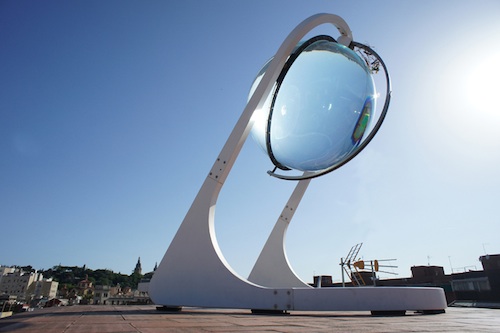Cool fact: every hour, the Sun provides the Earth with enough energy to power civilization for a year. Uncool fact: only about 34 percent of all sunlight hitting a solar cell can actually be converted to electricity at this point, meaning it’s not yet a cost-effective business — so the money is headed elsewhere (for now). The future of solar — at least the immediate future — is unclear, but people believe it could be the big thing down the road. Could a German architect help the world get there? Perhaps.
Andre Broessel designed something called “a spherical solar energy generator,” or BetaRay, with the help of a company called Rawlemon. You can read about it (and see some pictures) here, and the video embedded at the top of this post describes the concept as well. Here’s a pic of what it looks like:
So, how does it work? Well, it’s not quite simple, but … here’s the explainer:
The energy, however, arrives in the form of an energy-dense beam that’s concentrated up to 10,000 times. Above the miniature array of solar cells is a large water-filled glass orb that works similarly to a magnifying glass in focusing the light that’s present during all sorts of less-than-ideal conditions, like when skies are cloudy or when the only available light is the low-intensity illumination reflected by the moon.
The good thing about this design is that its conversion rate — which is typically around 34 in solar, as mentioned above — can range from 43 to 70. A 70 percent rate would require a five-or-six junction solar cell, as detailed here. Of course, the problem comes back to the same place and issue: money. Basic operations indicates that for something to be effective when produced, it has to be easily replicable on a large scale. That isn’t happening in solar, and it’s also a problem in ‘clean tech.’ This all goes in a big circle, because if the tech isn’t there to make it cost-effective to produce, investors aren’t interested — but you need the investors to develop the tech. For his part, here’s what Broessel says about the cost issues:
“You can optimize the conversion of light into energy all year round, even in bad weather,” he says. “It’s not unrealistic to think that in a year, it can double your energy yield.”
The basic theory there is “give me money because eventually, this will probably save you money,” which savvy investors probably don’t like the logical flow of. Broessel is currently looking for more funding, but having a tough time with it; based on European patent rights, the basic design and technology will be open-source in about a month. That could open the floodgates for more innovation in this space, potentially.
Here’s a paper from 2002 on global fossil fuel depletion. At that point, the belief was 230 more years of coal, and 166 more years of natural gas (about three-four generations, give or take). Other estimates are harsher. Eventually, solar energy (and electric cars) are going to have to become a legitimate thing. The Broessel/Rawlemon model might not be the answer yet, but it’s a step in the right direction to think about generating energy at a higher conversion and the ability to do it while it’s cloudy/overcast.


2 Comments
Comments are closed.